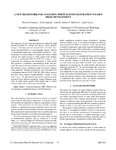| | Creator | Title | Description | Subject | Date |
|---|
| 1 |  | Clark, James Henry | 3-D Design of free-form B-Spline surfaces (CSTD-74-005) | This report describes an experimental system for designing free-form B-spline surfaces using a head-mounted display. In this system, the interaction with the surfaces takes place in three dimensions as the designed object's shape Is updated in real-time. The report also examines some of the problems... | Computer animation | 1974-09 |
| 2 |  | Sobh, Tarek M.; Henderson, Thomas C. | A dynamic framwork for intelligent inspection | CAD Computer Aided Design typically involves the design manufacture and inspection of a me chanical part. The problem of reverse engineering is to take an existing mechanical part as the point of departure and to inspect or produce a design and perhaps a manufacturing process for the part. ... | CAD; Manufacture; Inspection; Intelligent inspection | 1992 |
| 3 |  | Sobh, Tarek M.; Henderson, Thomas C. | A dynamic recursive structure for intelligent exploration | We suggest a new approach for inspection and reverse engineering applications. In particular, we investigate the use of discrete event dynamic systems (DEDS) to guide and control the active exploration and sensing of mechanical parts for industrial inspection and reverse engineering. We introduce dy... | Intelligent exploration; Discrete event dynamic systems; DEDS; Dynamic recursive finite state machines; DRFSM | 1992 |
| 4 |  | Sobh, Tarek M.; Henderson, Thomas C. | A dynamic recursive structure for intelligent inspection | We suggest a new approach for inspection and reverse engineering applications. In particular we investigate the use of discrete event dynamic systems DEDS to guide and control the active exploration and sensing of mechanical parts for industrial inspection and reverse engineering?? We introduce... | Intelligent inspection; Discrete event dynamic systems; DEDS; Industrial inspection; Dynamic recursive structure | 1992 |
| 5 |  | Whitaker, Ross T. | A fast iterative method for a class of Hamilton-Jacobi equations on parallel systems | In this paper we propose a novel computational technique, which we call the Fast Iterative Method (FIM), to solve a class of Hamilton- Jacobi (H-J) equations on massively parallel systems. The proposed method manages the list of active nodes and iteratively updates the solutions on those nodes u... | Fast Iterative Method; FIM; Parallel systems | 2007 |
| 6 |  | Smith, Kent F. | A fast parallel squarer based on divide-and-conquer | Fast and small squarers are needed in many applications such as image compression. A new family of high performance parallel squarers based on the divide-and-conquer method is reported. Our main result was realizing the basis cases of the divide-and-conquer recursion by using optimized n-bit primiti... | Squarer; Parallel squarers; Divide-and-conquer; MOPS; CMOS | 1995 |
| 7 |  | Henderson, Thomas C.; Hansen, Charles D. | A fault tolerant sensor scheme | Multi-sensor systems pose the problem of how to coherently and efficiently treat the data provided by the various sensors. However. the availability of greater numbers of sensors also broadens the ability to build fault tolerant sensor systems. We define a framework in which sensors can be abstractl... | Multi-sensor systems; Logical sensors | 1983 |
| 8 |  | Lindstrom, Gary E. | A framework for module-based language processors | A system composed of interconnected modules is a module-based system. We present an object-oriented (0-0) framework for the development of processors for module-based systems, such as compilers for 0-0 languages, linkers/loaders, and tools for user/system libraries. We claim t h a t this framework,... | Language processors; Jigsaw; Module-based | 1993 |
| 9 |  | Michell, Nick | A gallium arsenide mutual exclusion element | A mutual exclusion element is a key component in building asynchronous and self-timed circuits. As part of our effort to design high performance self-timed circuits, we have designed a mutual exclusion element in gallium arsenide. This circuit has been fabricated in a 1.2? process and tested. A test... | Mutual exclusion element; Self-timed circuits | 1993 |
| 10 |  | Mathew, Binu K.; Davis, Al; Fang, Zhen | A Gaussian probability accelerator for SPHINX 3 | Accurate real-time speech recognition is not currently possible in the mobile embedded space where the need for natural voice interfaces is clearly important. The continuous nature of speech recognition coupled with an inherently large working set creates significant cache interference with other... | Speech recognition; SPHINX 3; Speech recognizers | 2003-07-22 |
| 11 |  | Gopalakrishnan, Ganesh | A general compositional approach to verifying hierarchical cache coherence protocols | Modern chip multiprocessor (CMP) cache coherence protocols are extremely complex and error prone to design. Modern symbolic methods are unable to provide much leverage for this class of examples. In [1], we presented a method to verify hierarchical and inclusive versions of these protocols using ... | Hierarchical cache coherence protocols; Verification | 2006-11-26 |
| 12 |  | Yang, Yue; Gopalakrishnan, Ganesh; Lindstrom, Gary E. | A generic operational memory model specification framework for multithreaded program verification | Given the complicated nature of modern architectural and language level memory model designs, it is vital to have a systematic ap- proach for specifying memory consistency requirements that can support verification and promote understanding. In this paper, we develop a spec- ification methodolog... | Multithreaded program verification | 2003 |
| 13 |  | Lefohn, Aaron; Whitaker, Ross T. | A GPU-based, three-dimensional level set solver with curvature flow | Level set methods are a powerful tool for implicitly representing deformable surfaces. Since their inception, these techniques have been used to solve prob- lems in fields as varied as computer vision, scientific visualization, computer graphics and computational physics. With the power and flexi... | GPU-based; Level set solver | 2002-12-11 |
| 14 |  | Sobh, Tarek M. | A graphical environment and applications for discrete event and hybrid systems in robotics and automation | In this paper we present an overview for the development of a graphical environment for simulating, analyzing, synthesizing, monitoring, and controlling complex discrete event and hybrid systems within the robotics, automation, and intelligent system domain. We start by presenting an overview of di... | Intelligent system domain; Graphical environment | 1994 |
| 15 |  | Warnock, John E. | A hidden line algorithm for halftone picture representation | In exploring applications in computer graphics, one finds quickly that the representation of three dimensional objects in picture form is both a desirable and necessary capability. Applications dealing with any form of spatial design or with visual environment simulation need the ability to represen... | Halftone picture representation; Spatial design | 1968 |
| 16 |  | Cohen, Elaine | A hole-filling algorithm for triangular meshes | Data obtained by scanning 3D models typically contains missing pieces and holes. These can be caused due to scanning artifacts or artifacts in the surface due to wear and tear. We provide a method based on the Moving Least Squares projection to fill holes in triangular meshes obtained during the ... | Hole-filling algorithm; Triangular meshes; 3D models; Scanning | 2004-12-20 |
| 17 |  | Gerig, Guido | A joint framework for 4D segmentation and estimation of smooth temporal appearance changes | Medical imaging studies increasingly use longitudinal images of individual subjects in order to follow-up changes due to development, degeneration, disease progression or efficacy of therapeutic intervention. Repeated image data of individuals are highly correlated, and the strong causality of infor... | | 2014-01-01 |
| 18 |  | Starkey, Mike | A lisp-based occam interpreter | The OCCAM programming language is an implementation of Communicating Sequential Processes and is used in a number of different areas. These areas usually require explicitly describing small-grain paralleslism. OCCAM programs formed by such descriptions can be tested for correctness by executing the... | Lisp-based; Occam interpreter | 1991 |
| 19 |  | Bennion, Scott Thomas | A method of solution for hydrodynamics and radiation diffusion as a multi-material problem in one dimension | | Multi-material problem | 1971 |
| 20 |  | Weinstein, David | A morphing algorithm for generating near optimal grids: applications in computational medicine | We apply morphing to t h e problem of generating the initial mesh for finite element simulations. This algorithm reduces mesh adaptation time by integrating physical and geometric constraints to provide a near optimal initial mesh. We apply this method to large-scale bioelectric field problems invol... | Morphing algorithm; Bioelectric field problems | 1994 |
| 21 |  | Subrahmanyam, P.A. | A new approach to specifying and handling exceptions | An operation generally exhibits different patterns of behavior over different parts of its domain. Depending upon the context, such behavior may either be conceived of as "normal" or as an "exception." Thus, the behavior of an operation Is quite naturally characterized by the set of partial operatio... | Computer operations; Exceptions; Exception handling | 1980 |
| 22 |  | Bruderlin, Beat | A new approach to tolerance analysis | Tolerance analysis is seen as part of a more general problem, namely handling data with uncertainty. Uncertain geometric data arises when interpreting measured data, but also in solid modeling where floating point approximations are common, when representing design tolerances, or when dealing with l... | Tolerance analysis | 1994 |
| 23 |  | Kirby, Robert Michael II; Johnson, Christopher R. | A new family of variational-form-based regularizers for reconstructing epicardial potentials from body-surface mapping | We propose a new family of regularizers for the inverse ECG problem, using a variational principle that underlies finite element approximation methods. As an alternative to traditional Tikhonov regularizers, the variational formulation has several advantages: 1)it enables a simple construction of ... | | 2010 |
| 24 |  | Gerig, Guido | A new framework for analyzing white matter maturation in early brain development | The trajectory of early brain development is marked by rapid growth presented by volume but also by tissue property changes. Capturing regional characteristics of axonal structuring and myelination via neuroimaging requires analysis of longitudinal image data with multiple modalities. Complementary ... | | 2010-01-01 |
| 25 |  | Cohen, Elaine | A new local basis for designing with tensioned splines | Recently there has been a great deal of interest in the use of "tension" parameters to augment control mesh vertices as design handles for piecewise polynomials. A particular local cubic basis called p-splines, which has been termed a "generalization of B-splines", has been proposed as an appropriat... | Tensioned splines | 1985 |

























